It is a little-known fact that your car’s AC system can continue to run for longer than a day without oil. In most cases, you should be worried about the amount of refrigerant since the AC system only uses a few ounces of oil but much more refrigerant.
The recharge procedure is so delicate due to the restrictions on the type of oil used and the amount. The service manual will help you in this regard. Make sure you know which refrigerant oil to use since mixing oils such as the PAG and PAO can damage the compressor.
Bonus: Why Air Conditioner Only Works When Your Car Is Moving
Do I Need To Add Oil?
Adding oil to your AC system will usually happen if you replace any major components in the system. After replacing the component, you must recharge the system to maintain the seal and prevent leaks. With that in mind, manufacturers ensure these replacement parts, such as the compressors, come with a set amount of oil in them.
The oil serves as a lubricating agent to the AC system’s components, i.e., the compressor. The refrigerant is the only cooling fluid in the system, and the oil helps lubricate the moving parts of the compressor. This lubrication reduces friction and minimizes mechanical damage to the system. Moreover, the seal between the low- and high-pressure sides of the AC compressor is kept tight by the oil.
As much as the oil is beneficial, too much of it can saturate the system and cause malfunctions. Refilling the oil is a tricky process that can affect the AC system further if done incorrectly. That is why the replacement components come with oil in them to make the recharge process much easier. Moreover, you can opt to use refrigerant cans with prefilled oil levels.
As you can tell, you will typically not need to add oil to your system. The only exception will be when performing system repairs, such as fixing a leak in the system. In these cases, you will first have to evacuate the AC system before proceeding to recharge the system. The reason for this is to ensure the oil isn’t oversaturated because some may be in the compressor.
It should be noted that evacuation must be done by professionals with the proper evacuation machine. This is because refrigerants are toxic to the environment. It is, therefore, illegal to release any refrigerant into the atmosphere, and that is why we usually need specialized machines and personnel to do the recharge procedures.
How Much Oil Should I Add?
Where To Find The Information About The Right Amount Of Oil

The user or repair manual for your vehicle will recommend a specific amount of refrigerant oil. Additionally, the AC system itself has specifications that showcase the amount of oil it requires. There are average amounts of oil (about 4 ounces) you can use as a rule of thumb but look at the owner’s manual to err on the side of caution.
There are stickers under the hood of your car or on the railing enclosed by the hood. These stickers will often have refrigerant information such as the type of refrigerant to use, which oil to get, the recommended amounts, and cautions on what not to do. For example, if your vehicle runs on HFC134a refrigerant, the sticker will show the maximum amount of refrigerant needed (630 grams/1.39 lbs.) and the minimum amount (570 grams/1.26 lbs.). It also shows the type of refrigerant oil, which is usually RL-897 or an equivalent model.
If none of the above is available, you can measure the old oil still remains in the compressor and add no more than this amount to err on the side of caution. However, the best course of action would be contacting your A/C compressor manufacturer for the exact required amount.
You should ensure you do not overfill the system with a lot of oil since this will reduce the performance. On the other hand, adding little oil will lead to compression failures by increasing the heat and friction.
AC Compressor Oil Capacity Chart
The oil capacity in your AC compressor is not only affected by the amount of added oil but also the type of oil. The compressors are built to use specific lubricants with specific friction and viscosity characteristics. Different oils like PAG 100, PAG 46, and PAG 150 have varying properties that make them incompatible.
However, there are a few tolerances that can allow you to use universal AC compressor oils. They are not as efficient as the compressor-specific oil but will do the job in some systems. You should avoid the universal oils if you do not want to take any chances.
A majority of the vehicles from 1996 and newer ones use R134a refrigerant. This type uses Polyalkylene Glycol (PAG) Oil in the compressor system. Due to this standardization, it has become easier to gauge how much oil you should add to each AC component:
| Accumulator | 1 ounce |
| AC hoses | 1 ounce |
| Condenser | 1 ounce |
| Evaporator | 1.5 ounces |
| Compressor | 1.4 ounces |
The total amount of added oil is usually 4 ounces which means that the sum of oil in all the components shouldn’t be higher than 4. This number will depend on your car’s AC system oil capacity.
How To Choose The Right Oil For My AC
The most significant contributor to AC compressor failures is the use of incompatible oils and refrigerants. The use of incompatible fluids will inevitably destroy the compressor due to the different viscosity properties.
A slight change in viscosity will change the frictional resistance in the system, resulting in varying compressor temperatures. This variation will lead to inadequate lubrication, increased friction, and damaged seals.
The majority of universal oils used in garages are PAO (Plyalphaolefin) based and not PAG-based. Some manufacturers approve of the use of these PAO oils, but the majority do not. The reason for that is because the PAO oils mix inconsistently with PAG oils resulting in increased heat, poor lubrication, and wear.
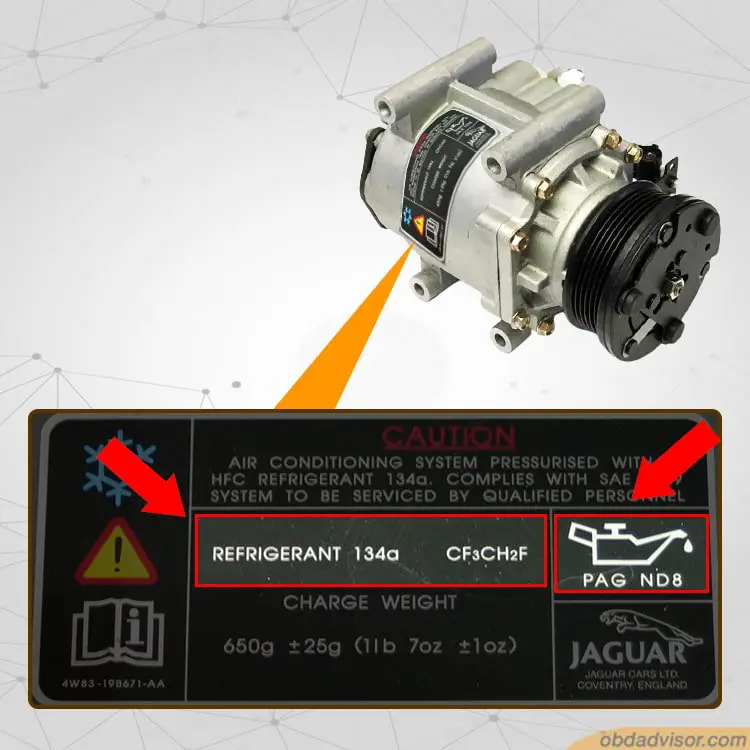
To avoid any future failures and lengthen the life span of your compressor, it is advisable to first check the compressor label before recharging the system. This identification label is usually on the rear or side of the compressor. The label will detail the specific lubricant and refrigerant you should use to avoid incompatibility issues.
Even though universal oils may save you some time and money, they may eventually damage your compressor. Not only that, using an incompatible fluid will void your warranty of that compressor, leading to more repair costs.
Some garages use universal oils to recharge the system, which means that your warranty can be void without your knowledge. It would be best if you find a trustworthy mechanic or perform the procedure yourself.
AC Oil Compatibility Chart
| R1234yf/HFO-1234yf | ||||
|---|---|---|---|---|
| MINERAL OIL (Alkyl Benzene Oil) | ✔ | -- | -- | |
| PAG OIL (Polyalkylene Glycol Oil) | -- | ✔ | • PAG Oil YF. • PAG Oil SP-A2. | |
| POE OIL (Polyol Ester/Retrofit Oil) | ✔ | ✔ | -- | |
| PAO OIL (Polyalphaolefin Oil) | ✔ | • PAO AA1 clear version (without leak detecting agent.) • PAO AA1 PLUS UV. • PAO AA3 clear version. • PAO AA3 PLUS UV. | • PAO oil AA1 clear version. • PAO AA3 clear version. |
- Recommended mineral oils:
TSI Supercool Mineral Oil – 128 oz

Price range: $38-$48
TSI Supercool Mineral Oil – 32 oz
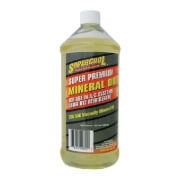
Price range: $14-$24
Four Seasons Mineral Oil – 32 oz
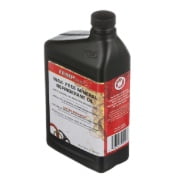
Price range: $12-$22
- Recommended PAG oils:
TSI Supercool PAG 46 Oil – 32 oz
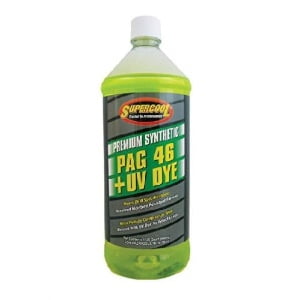
Price range: $22-$32
TSI Supercool PAG 100 Oil – 8 oz
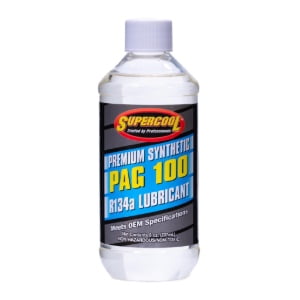
Price range: $2-$12
- Recommended POE oils:
TSI Supercool POE 68 Oil – 128 oz
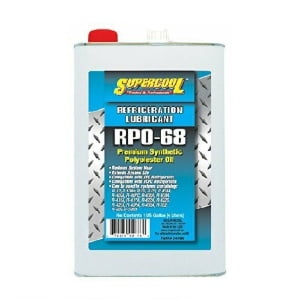
Price range: $75-$85
TSI Supercool Ester Oil – 8 oz
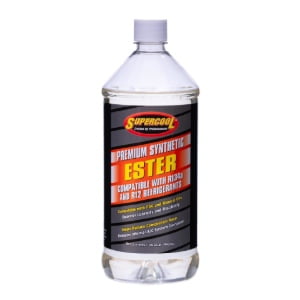
Price range: $2-$12
- Recommended PAO oils:
TSI Supercool PAO 68 Oil – 32 oz
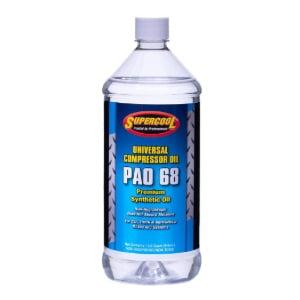
Price range: $17-$27
Petrochem PAO 46 Oil – 128 oz
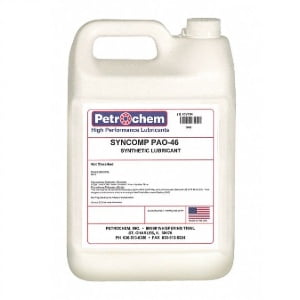
Price range: $140-$150
How To Add Oil To An AC Compressor
You will need a recovery machine that will help remove the refrigerant per EPA standards. The recovery machine is used to detect leaks and recharge the AC system after an AC component repair. It works by creating a vacuum in the AC system and sucking the refrigerant out of the car.
It then cleans the refrigerant and seals it in a storage tank. After the repairs are done, the machine will remove all air and moisture in the system so that the refrigerant can be put back in.
You can usually take your car to any mechanic shop with the proper machine to have the refrigerant removed. Most shops offer to do it free of charge.
There are a handful of ways to add oil to an AC compressor. However, the safest bet would be doing it while the compressor is disconnected so you can drain the old oil. Otherwise, it would be very difficult to determine how much oil is still in the compressor to ensure you won’t under or overfill.
- Step 1 – Disconnect the air compressor from the system by first locating it. Then remove the low and high pressure hoses from the AC compressor. Cover the end of the disconnected hoses to prevent any contaminations. Remove the electrical connection as well as the bolts from the compressor and it will come out.
- Step 2 – Take off the cap on the rear end of the compressor and hold it upside down to remove the old oil. Turn the clutch to help all the oil come out of the compressor.
- Step 3 – Add in the new oil as per the manufacturer’s requirements to the compressor.
- Step 4 – Reattach the compressor into the AC system, ensure every seal is kept tight and no inclusions enter the system.
After this, you can have the unit vacuumed of all air and moisture either by going back to a mechanic shop and make use of their recovery machine or by using a vacuum pump yourself. For the former, the machine will detect any leaks in the compressor. If there is any, you must repair it before attempting to recharge with refrigerant, as it will continue to leak otherwise. If you don’t have a recovery machine at your disposal, you can detect leaks by using an A/C pressure gauge.
Conclusion
Now you know what to do when it comes to adding oil while recharging the AC compressor. Note that the biggest issue is the amount of oil you should add and the type of oil to use. The AC compressor is a durable component that won’t malfunction for years if you use the compatible fluids recommended by the car or compressor manufacturer.
The recharge procedure for the AC system is delicate and very tricky if you are not an experienced technician. It is advisable to take the vehicle to your local repair shop to have the AC issue checked out.
Read more: